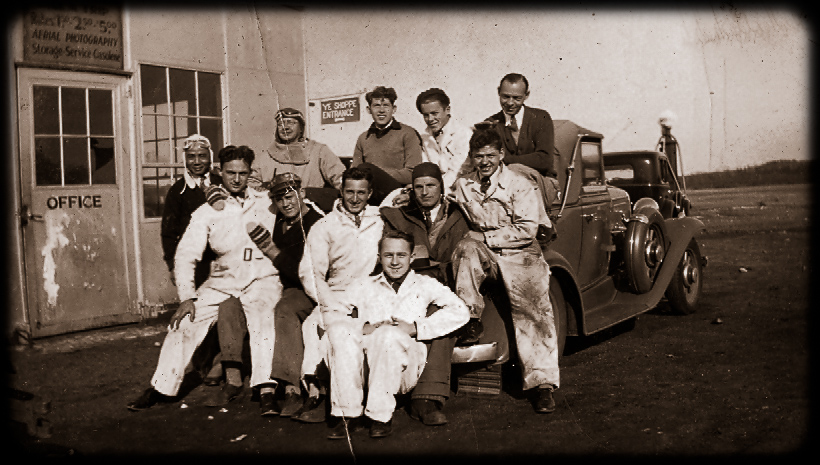Women’s History Month: Dottie Shaw takes wing
By George T. ComeauThis story originally appeared in the Canton Citizen on June 16, 2011 and is being reprinted in celebration of Women’s History Month.
Childhood should be a time of innocence, of youthful diversions and a time when you begin to see the world as your own and find a place within. You do, however, grow up fast when a family depends upon you to bring them together, even if you are just a child.
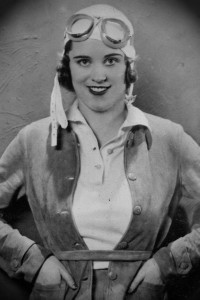
Dorothy Shaw’s formal portrait in full pilot regalia, circa 1940s (Courtesy of the Canton Historical Society)
Dorothy Shaw grew up on Everett Street, that small street at the intersection where Chapman and Spaulding streets meet. “Dottie,” as she was affectionately known, was born in 1910 and was surrounded by a loving family that included a sister and two brothers. The house, still standing, had a magical turret and is one of the prettiest houses facing Chapman Street. Dottie’s father was a well-respected builder and her mother filled the house with love and affection.
Fannie Shaw, Dottie’s mother, was born in 1878, and her parents died shortly after she was born. Adopted by Mr. and Mrs. Henry Cushman, the girl thrived at the Crane School and was married at age 19 to Walter Shaw in 1897.
Dottie’s catapult from childhood into adulthood happened when she was 13 years old. Her mother had been seriously ill from the time Dottie was 10 years old. The illness was quite bad, and for three years Fannie Shaw endured several strokes and convulsions, leading to diminished eyesight and poor speech. At 1 a.m. on February 23, 1923, Fannie Shaw died, leaving the family in the care of her only daughter. It would be an understatement to suggest that this was difficult. Taking care of her brothers and father became a full-time job, and in addition to her schoolwork, there was always a mountain of chores to be attended to across the day and late into the night.
Taking care of siblings Walter Jr., Howard and Florence was only part of her job; balancing school was the other. Dottie excelled in all her subjects. As part of the Canton High School graduating class of 1926, Dottie graduated at the top of the class and was not only the class president but the valedictorian as well. In short, this was an extremely smart young woman.
As it turns out, there were several smart women around town in those years. Dorothy Spear would go on to attend Bates College in Maine, while Kay Draper attended Wheaton. Not to be outdone, Dr. Rubin’s wife, Sophie, went to Radcliffe, and so many of her friends began life after Canton in wonderful and far-flung places. In writing her introduction to the Echo Yearbook, Dottie noted: “Years ago, there might have been excuse for students not going to college, but in this era of opportunities there is no one who cannot go to a higher institution … there are many ways for poor students to earn tuition.” Dottie wanted to desperately go to college, yet it was not to be. Keeping the family together was her focus, and soon she found a job in the local Boston Edison office in Canton Center where she was always a smiling face well known to many of Canton’s residents.
It would be the skies that would capture Dottie’s dreams. Everett Street is at the top of the Neponset Valley, and photographs from the turn of the last century show a broad expanse across which one could see straight to Norwood. By the early 1930s, the Canton Airport was in full throttle, and Dottie could see and hear the “airships” taxiing and lifting into the sky and roaring over her house. The idea of flying was one that captured many young hearts in those days, and Dottie’s was not excepted.
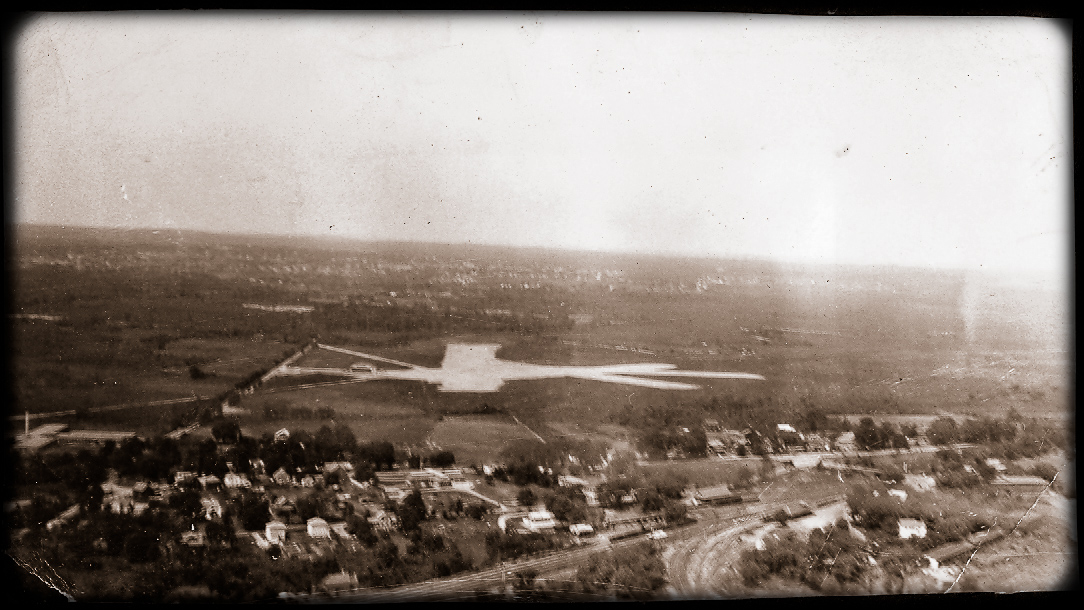
An aerial view of Chapman Street with the Canton Airport in the background. Photo taken by Dottie Shaw in 1933. (Courtesy of Jane Boland)
Perhaps it was Amelia Earhart who made an impression on 18-year-old Dottie Shaw. On June 17, 1928, it was Earhart who set off from Trepassey Harbor in Newfoundland and 21 hours later landed at Burry Port, Wales. The headlines were fantastic, and while three women had previously died attempting a transatlantic crossing, it was Earhart who was greeted by ticker tape and President Calvin Coolidge. Whoever it was who influenced her, Dottie Shaw was indeed influenced to take to the skies. While other young women were off in college, Dottie decided that one thing she could do to set herself apart would be to fly. To fly – to soar – to glide – to dream. Saving a small portion of her $16 paycheck each week, Dottie was able to scrape enough together to begin flying lessons at the Canton Airport. Walking to the airport, less than a mile from her house, was a weekly ritual. And if she was lucky, she could grab a ride from friends — including Ralph Beasley or his son Ralph Jr. These were heady days in aviation. Takeoffs were easy; it was the landings that would prove tricky. In August 1932 a flight permit was issued to the intrepid D.B. Shaw. One of the early masters of aviation took on Dottie Shaw as a student. G. Bancroft Hall, or “Banny” as he was known, would teach Dottie how to fly.
G. Bancroft Hall was a fixture in early New England flying, and by all accounts he favored Dottie with his vast knowledge of piloting. In 1929, Hall was a partner in the Wachusett Airways Company in Fitchburg and at the same time the chief pilot at Canton-based Wiggins Airways. In an old, dog-eared scrapbook, Dottie writes of Banny — “God’s gift to women students.” Taking to the skies for women became pretty extraordinary in the early 1930s, and yet there were several notable examples, largely from well-to-do families.
Flying was as much about the freedom of being in the skies as it was the camaraderie of the fellowship, and Dottie loved the people and the stories that were part of this sport. At the municipal airport in Canton there was a close-knit group of friends, and Dottie was certainly included. The “Gang” was Chin Jung, Ralph Beasley and his son, Ralph Jr., Dick Chase, Sumner Fischer, Charles “Scottie” Scott, Appellino “Red” Janeskus — from Stoughton, Uno Frederickson and several other “guys.” Dottie was the only woman flying in the group. Even in her canvas coveralls and grease-smudged nose, Dottie was a beautiful woman with a ready smile and a winning personality.
On Thursday, June 8, 1933, Dottie climbed into the single cockpit Spartan C2-60 monoplane, the “Trusty 902.” At 5’4” and 100 pounds soaking wet, the blonde, blue-eyed kid slid behind the controls. This would be her first solo flight, and she was probably quite nervous. Inscribed in the front of her scrapbook is an old saying: There are “old” pilots and there are “bold” pilots, but there are no “old, bold” pilots.
At 23, Dottie Shaw was certainly not old, but as for being bold, this is up for interpretation. It was a beautiful summer evening; a slight breeze kicked up the smell of sweet grass from the nearby hayfields. The runway was dusty as she taxied out and made the turn for her takeoff. At exactly 7:11 p.m., Canton’s first female pilot took flight from the soft grass meadow at the airport at the edge of the Fowl Meadows. Aloft above her beloved town, it was a magical evening. The small engine could get her up to a top speed of 93 mph and she must have reveled in the private view of Canton. Pulse quickened as she maneuvered on her own without Banny to gently guide her. After six hours of training spread over the course of a year, this was her moment, her dream of flying realized.
On the ground a welcome committee was sure to be waiting. Perhaps her fellow students had stopped by, and certainly her instructor. At the head of the pack may have been Joe Garside. Joe came from a wealthy family in Hyde Park that had made a small fortune developing a special paint for canvas-covered planes. In 1927, he piloted his mother across the English Channel from Paris to London — Joe was only 13 at the time.
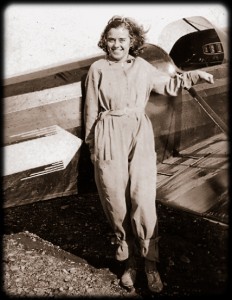
Dorothy Shaw, Canton’s first aviatrix, posing in front of her “solo” ship in 1933 at the Canton Airport (Courtesy of Jane Boland)
As far as formal instruction, Joe learned to fly in Charlotte, North Carolina, and a year later we find him soaring around the nation’s capital and the Washington Monument. The 14 year old soloed in 1928 at Hoover Field in Washington, D.C. (now the site of the Pentagon). Joe had tried to persuade the chief of the Department of Commerce (now the FAA) to waive the 16-year-old age requirement for private pilots. At the time, Joe Garside was the youngest pilot to solo in the world. The flight was a success; the waiver was not. Despite not having a pilot’s license, Joe flew extensively and by age 16 became a full-fledged pilot, owning several air-ships.
At 19, Joe Garside, very well known in early flying circles, became the manager of Wiggins Airways in Canton. Close to his home in Milton, Joe was an early pioneer of commercial aviation and attended MIT, studying aeronautical engineering. Of the 40 students who came for lessons, Dottie stood out. Spending more of her time at the Canton Airport, she soon became an assistant to the dashing, young airport manager. It would not be long before the two became an item. Eventually, the “air-pair” fell in love and began an extended courtship. In October 1938, Joe and Dottie were married and moved to the beautiful stone house at 180 Chapman Street.
Joe and Dottie were a well-suited pair — smart, ambitious and very friendly. In fact, both were described as having magnetic personalities. After ten years of trying to have a child, they turned to a family attorney in Brockton, who arranged for them to adopt a nine-day-old baby girl. Jane Garside said that from the time she was old enough to know, she knew she was adopted. “I was a very fortunate child,” she recalls. “I never desired to hunt for my birth mother, and Joe and Dottie were my mom and dad.” Jane was told from day one that she was special.
Dottie flew until the 1940s, joining the famous Ninety Nines, a women’s pilot organization founded by Amelia Earhart. After Jane was born, Dottie never piloted again. The family did fly together in small private planes, but Dottie exchanged her wings for the caring arms of a mom.
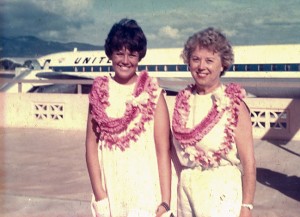
Dorothy Shaw Garside in Honolulu, Hawaii, with her daughter, Jane, in 1963 (Courtesy of the Canton Historical Society)
When Jane was 13 years old, her mom and dad divorced. In the mid 1950s, Joe engaged in a particularly public and forbidden love affair with a neighbor’s wife. Dottie asked him to move on by simply stating in rather stoic terms: “You can do whatever you want. I am keeping our house and Janie.” Jane continued to see her dad, but certainly was closest to her mother. The split was amicable even under the circumstances. In later years, Joe would reflect that his divorce was perhaps the biggest mistake he ever made in his life. Dottie remained on benevolent terms with her ex-husband, most likely because they were such close friends. Today we call people like Joe and Dottie soul mates.
Dottie’s life in Canton continued to be a proud and lasting tribute to the things she loved. A member of the Garden Club, the Sweet Adelines, and the Canton Historical Society, she remained active her entire life, and was frequently seen volunteering at Norwood Hospital as a “pink lady.” Jane recalls that her mother “had a beautiful voice” and loved organizing community activities, including the 50th anniversary of her Canton High School graduating class. In the winter of 1978, Dottie battled a nasty flu, and soon it was discovered that she was suffering from heart disease, which quickly led to two heart attacks, the second fatal. On January 4, her 68th birthday, Canton’s first female pilot departed this earth.
Short URL: https://www.thecantoncitizen.com/?p=5962

